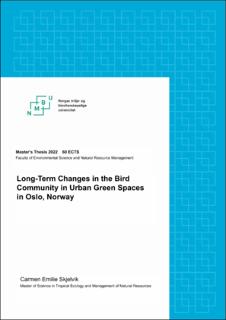| dc.description.abstract | Urban areas are becoming increasingly dominant worldwide, and studies of long-term trends in urban bird populations are necessary to evaluate the impact cities have on wildlife and the ecosystem function upon which humans depend. However, few studies to date have examined long-term population trends of birds in urban areas. This study aimed to document the long-term bird population trends in urban green spaces. Birds were censused in 93 green spaces in Oslo, Norway. The first census was conducted in 2005-2007, and the second census was conducted approximately 15 years later, in 2021. Population trends for 45 breeding land bird species were considered, and ecological traits including body mass and brain size, migration strategy, nest site selection, diet, habitat preference, and red list status were considered as potentially contributing factors to population change. Additionally, population trends in Oslo were compared to national trends in Norway and Sweden to examine whether urban birds in Oslo exhibit different trends from the species in general. This study found evidence that migratory species declined relative to resident species, and populations of diet specialists and farmland species declined. Contrary to predictions based on previous studies of the importance of brain size for urban living, I found that brain size did not contribute to the long-term changes in the bird communities in Oslo. Overall, there was no significant change in the number of individuals or occupancy in Oslo over the last 15 years. The population trends were consistent with the temporal changes from the national counting in Sweden and close to observed population changes in Norway. These results suggest that population changes in urban environments are influenced by the same factors as the bird communities at the national scale. Thus, there was no evidence that urban bird species had population trends differing from those of birds at a wider scale. | en_US |

